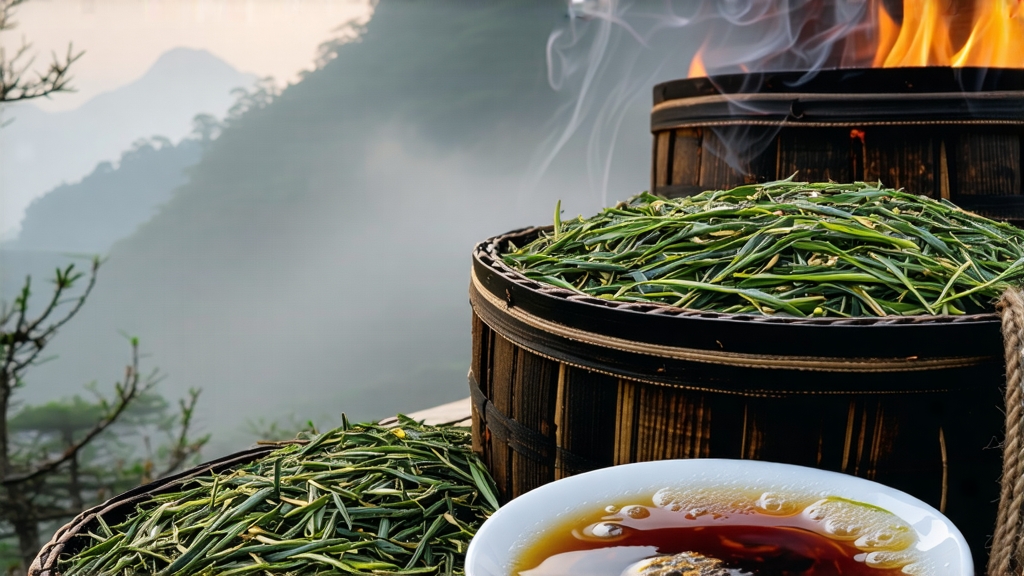
If every family tree has a revered elder, then Lapsang Souchong—pronounced “laap-sang sou-chong”—is the patriarch of the entire black-tea world. Long before Assam, Ceylon, or Keemun were even imagined, this small, twisted leaf from the rocky Wuyi massif in China’s Fujian province was already traveling the Siberian caravan routes, scenting the air with campfire memories and convincing European merchants that tea could be more than green. Today, when sommeliers speak of “terroir-driven” teas, they are, knowingly or not, echoing the vocabulary first inspired by Lapsang Souchong’s resinous swagger.
1. A leaf born of chaos
Legend fixes the birth year around 1567, late Ming dynasty, when Qing-era soldiers allegedly commandeered a tea farm near Tongmu village. In haste to dry the leaves before the troops returned, farmers spread them over smoldering pine boughs. The accidental smoke infusion not only saved the crop but created a flavor so arresting that Dutch buyers paid double. By 1604 the first chests reached Amsterdam; London followed, and “bohea” (a corruption of “Wuyi”) became the generic English word for the new, fully oxidized category Europeans would soon call “black tea,” while the Chinese continued to name it hong cha—“red tea”—for the color of its liquor, not its leaf.
2. Geography that tastes like stone
Tongmu Guan, the original micro-valley, sits inside a national park buffer zone where granite cliffs force humid air to rise, cool, and condense into a perpetual mist. Day-night temperature swings of 15 °C slow leaf growth, concentrating amino acids and volatiles. The soil is a thin, acidic layer of weathered tuff and pine humus—too poor for rice, perfect for tea. Chinese law now restricts tea production to 52 square kilometres; anything grown outside may be labeled “Wuyi black,” but only Tongmu leaf may legally bear the name Zheng Shan Xiao Zhong (“Original Mountain Small Sort”).
3. Two faces of smoke: Traditional vs. Modern
Purists divide Lapsang Souchong into two stylistic camps.
Traditional (Song Zhong): The leaves are withered over local Masson pine fires, rolled, oxidized in bamboo baskets, then smoked a second time in a dry room called a qing lou where pine embers are kept at 70–80 °C for up to eight hours. The finished tea smells like a pine-tar soap crossed with dried longan; the smoke is dense yet sweet, never acrid.
Modern (Wu Yan): Responding to twenty-first-century palates that favor malt over campfire, many Tongmu families now craft an unsmoked version. They wither over warm air ducts, oxidize normally, and bake at low temperature, producing a honeyed, dried-apricot liquor that still carries the Wuyi minerality. Both styles share the same cultivar—predominantly Xiao Ye Zhong (“small-leaf species”), a close cousin of the shrub that gives us Da Hong Pao.
4. Craft in five acts
- Picking: One bud plus two leaves, 5–7 cm long, harvested between Qingming and Grain Rain when spring nights remain cool.
- Withering: 8–10 hours on slatted bamboo racks suspended above pine embers; moisture drops from 75 % to 45 %.
- Rolling: 40 minutes of machine-assisted bruising ruptures cells, starting oxidation; traditionalists finish with 5 minutes of hand-rolling to shape the signature tight fish-hook curl.
- Oxidation: Leaves rest 3–4 hours in cedar-lined trays kept at 24 °C and 80 % humidity, turning from jade to mahogany.
- Smoking & Drying: The crucial bifurcation. Traditional lots pass through the qing lou; modern lots enter an electric oven at 90 °C until moisture falls below 7 %.
5. Brewing: Gongfu versus Western
Because Lapsang Souchong is both robust and nuanced, it rewards attention but forgives mistakes.
Gongfu (preferred):
- 5 g leaf in a 120 ml gaiwan or Yixing pot.
- Rinse